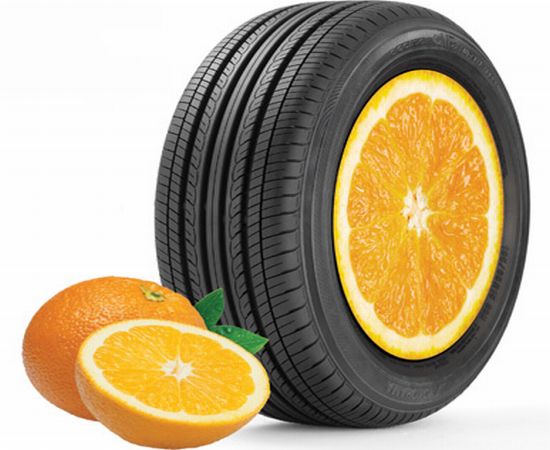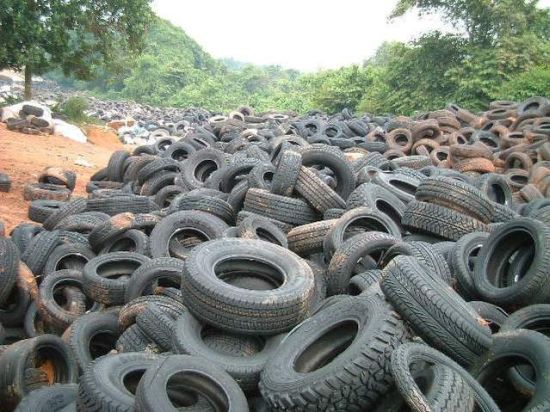
Image credit
In the history of automobile tires, initially only natural rubber was used by manufacturers which was recyclable. The shape of thing took a turn after Charles Goodyear invented vulcanized rubber in 1844. The new improved rubber was more durable and resistant to chemical attack. The surface was smoother and did not stick to metal or plastic. But, the flip side of this better version was that it was not recyclable. The metamorphosed tire we know today is a blessing to the automobile world but at the same time is not environment friendly. Automobile tires contain about 30 kinds of synthetic rubber, 8 types of carbon black, steel cord, polyester, nylon, steel bead wire, silica and 40 different kinds of chemicals, waxes, oils and pigments. Modern tires contain little or no recycled rubber as it limits performance and increases fuel consumption.
The environmental and health impacts
Tiny particles that wear off from automobile tires moving on the road can add up to huge problems. Tire rubber contains heavy metals like zinc and cadmium, hydrocarbons, latex, and sulfur-containing compounds. These wear particles may affect organisms in water habitats and aggravate respiratory problems in human beings. Environmental pollution is also caused by CO2 emission due to rolling resistance. Apart from this, huge amounts of toxic gases are released into the air when vulcanized rubber is burnt, a process which can go on for months and its hard to stop too. Huge mountains of dumped tires are lying discarded in landfill across the globe. These landfills are potential grounds for infestation and fires. These dumps also have a very detrimental land-use impact.
Can natural rubber make a comeback?

Image credit
Yes it can, and indeed it has. A few alternatives to vulcanized rubber have been experimented with in the past. The latest breakthrough in this field has been by Yokohama Tire Corporation which has introduced the world’s first orange-oil infused automobile tire. The consumers would save money because fuel efficiency will improve due to 20% reduction in rolling resistance. The dB Super E-spec could very well be the most technologically-advanced tire ever produced. Since orange oil had a molecular structure similar to natural rubber it soften the rubber and is easier to recycle. According to Dan King, Yokohama vice president of sales…
The eco-focused dB Super E-spec mixes sustainable orange oil and natural rubber to drastically cut the use of petroleum, without compromising performance.
Other Alternatives
Urethane Tires: Urethane is made of tightly knit 3-D lattice, that is both durable and flexible. Since it is made up by mixing just two chemical building locks, they form interlocking chains quickly. Also, urethane doesn’t require heat for hardening. Although research on urethane began as early as the 50’s, the effort was abandoned in 70’s because the substance did not provide as much traction or puncture resistance as rubber tires.
Soy flour: Tire fillers usually contain petroleum based particles called carbon black. Although carbon black enhances the tires wear resistance and tensile strength, it is both expensive and a rich source of pollution. Therefore scientists are researching upon the viability of soy flour as a cheap alternative to carbon black. The spin-off would be reduction in pollution causing gases.
Alternative Oils[PDF] : Highly aromatic oils are derivatives of the petrochemical industry. They contribute to the road adherence properties of the tire. Polyclinic aromatic hydrocarbons are components of aromatic oils. PAH’s are carcinogenic and are known to cause harm to human health. MES and TDAE are two alternative oils to aromatic oils. Ther are problems , however, with the availability of these oils. Besides, there may be a loss on the end of performance and road safety may be negatively affected.
Recycling and Reclaiming

Image credit
De-vulcanization : Since rubber contains metals which render it useless for recycling, shredded tires are mainly used as material for road construction. Changing it to rubber can be really expensive. This is the primary reason of mountains of used tires lying as waste. This not only spoils the landscape but also increases the environmental risk. Rubber can be de-vulcanized in which the removal of sulfur bonds returns the rubber into workable rubber again so that it can be use again.
End-of life tires[PDF]: Virtually one tire per vehicle is discarded each year in the developed countries. Each year an overwhelming figure of 1 billion of discarded tires is generated. Instead of treating this as waste it can be utilized in any of the following ways:
• To Save the virgin and scarce natural resources.
• To be used instead of fossil fuels in some cases and help curb CO2, Nox and Sox emissions.
• Can be used in civil reconstruction projects as crumb/ground rubber and as an alternative to coal in steel manufacturing.
The tire has been around ever since automobiles came into existence. Since dumped tires take virtually millions of years to vanish, both the consumer and manufacturers need to take this issue seriously. An environmentally benign alternative is always better, but the graver issue to address is the vast accumulation of non recyclable tires marring the earth’s beautiful landscape. The problem is far worse than most of us reckon it to be. But, its never too late to act.




